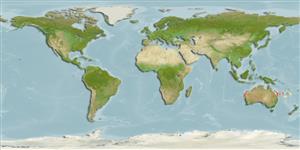Elasmobranchii (sharks and rays) >
Myliobatiformes (Stingrays) >
Urolophidae (Round rays)
Etymology: Urolophus: Greek, oura = tail + Greek, lophos = crest (Ref. 45335).
More on authors: Last & Gomon.
Environment: milieu / climate zone / depth range / distribution range
Ecology
Marine; demersal; depth range 60 - 300 m (Ref. 9863). Tropical; 19°S - 29°S
Indo-West Pacific: Australia. Resembles Urolophus bucculentus with which it overlaps in distribution in southern Queensland.
Size / Weight / Age
Maturity: Lm ? range ? - ? cm
Max length : 59.0 cm TL male/unsexed; (Ref. 6871)
Occurs on the continental shelf and uppermost slope (Ref. 9863). One of the largest tropical Australian stingarees.
Life cycle and mating behavior
Maturities | Reproduction | Spawnings | Egg(s) | Fecundities | Larvae
Last, P.R. and J.D. Stevens, 1994. Sharks and rays of Australia. CSIRO, Australia. 513 p. (Ref. 6871)
IUCN Red List Status (Ref. 130435)
Threat to humans
Venomous
Human uses
Tools
Special reports
Download XML
Internet sources
Estimates based on models
Preferred temperature (Ref.
123201): 20 - 23.3, mean 21.9 °C (based on 17 cells).
Phylogenetic diversity index (Ref.
82804): PD
50 = 0.5000 [Uniqueness, from 0.5 = low to 2.0 = high].
Bayesian length-weight: a=0.00813 (0.00366 - 0.01807), b=3.08 (2.88 - 3.28), in cm total length, based on LWR estimates for this (Sub)family-body shape (Ref.
93245).
Trophic level (Ref.
69278): 3.6 ±0.4 se; based on size and trophs of closest relatives
Resilience (Ref.
120179): Low, minimum population doubling time 4.5 - 14 years (Assuming fecundity<100).
Fishing Vulnerability (Ref.
59153): Moderate vulnerability (44 of 100).
